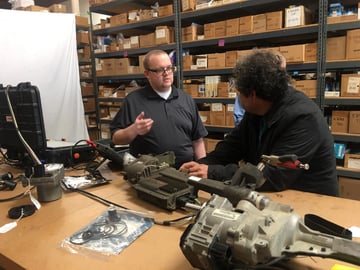Common EPS Mechanical Failure Types to Look For
When you're dealing with modern EPS systems in your shop, the bulk of the issues and failures you'll be dealing with will likely be related to electronics: components, sensors, boards, circuitry, communication, and more. However, that doesn't mean you will never come across mechanical failures in these vehicles as well, and you should be sure that your team of technicians is prepared to diagnose and repair them. While there are many different potential error codes and mechanical failure types to look for, your first priority should be to familiarize yourself with the most frequently diagnosed types.
In this post, we'll describe the most common EPS mechanical failure types to look for during the diagnostic process and discuss how you can approach rebuilding and repairing these issues.
Main Types of Mechanical EPS Failures
- Rack bar bushings: The first failure type to be on the lookout for during inspection and diagnosis are issues or failures related to rack bar bushings. Rack bar bushings can wear down due to reciprocation without lubricant and/or radial loading. This causes noise and excessive strain on the vehicle's motor and electronics, which can lead to increased issues down the line if left unaddressed.
- Bearings: EPS mechanical systems can also experience failures if issues occur with the system's bearings. Infiltration of the environment by debris such as water, dirt, or other contaminants will cause mechanical failures in the electronic power steering system. This type of failure will also cause excessive noise and strain on the motor and electronics.
- Electrical connection points: Electrical connection points comprise another mechanical area prone to failure within EPS systems. In particular, physical damage to the electrical connectors due to core handling or improper removal from the vehicle can lead to significant mechanical failure modes.
- Sealing components: Finally, the sealing components within the EPS system are subject to potential failure. These components include the shaft seal, housing seal, and reservoir seal. These sealing components can fail due to general wear or cracking over time, improper installation or fit in the system, and leaks or contamination within the system that break down the seal material.
Repairing and Rebuilding EPS Mechanical System Components
 Choosing to repair both the mechanical and electronic issues with EPS systems in today's vehicles can give your power steering business a major edge over your competition for a variety of reasons. Namely, the OEM/dealership will generally be more interested in replacing the entire EPS system if an issue occurs rather than repairing one or more components, leading to increased costs and wait times for potential customers. However, by learning how to service EPS systems in your shop, you're able to provide the same customers with a better option that cuts their costs and wait times significantly.
Choosing to repair both the mechanical and electronic issues with EPS systems in today's vehicles can give your power steering business a major edge over your competition for a variety of reasons. Namely, the OEM/dealership will generally be more interested in replacing the entire EPS system if an issue occurs rather than repairing one or more components, leading to increased costs and wait times for potential customers. However, by learning how to service EPS systems in your shop, you're able to provide the same customers with a better option that cuts their costs and wait times significantly.
However, there is one major roadblock keeping many power steering businesses from transitioning to EPS service today. OEMs tend to keep their EPS technologies and designs proprietary, and the rebuild seals and components you need to make these repairs can be difficult or impossible to find in the aftermarket unless you have the right parts supplier as your partner. In order to continue to build your business around the future of EPS, you'll need to make sure you partner with a parts supplier that has strong relationship ties to the original equipment manufacturers. These suppliers can help you source the rebuild components and training you need to address both mechanical and electronic failures in these systems.

